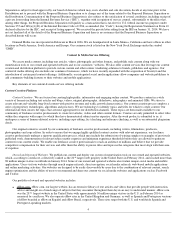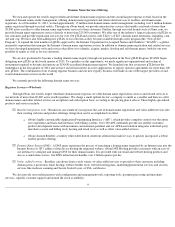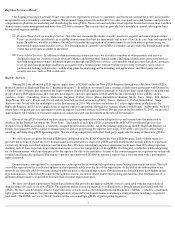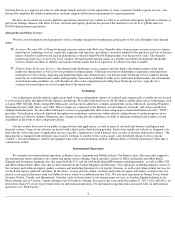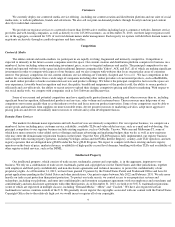Enom 2013 Annual Report Download - page 15
Download and view the complete annual report
Please find page 15 of the 2013 Enom annual report below. You can navigate through the pages in the report by either clicking on the pages listed below, or by using the keyword search tool below to find specific information within the annual report.
select removals and additions. In response to changes in search engine algorithms since 2011, we have performed evaluations of our existing
content library to identify potential improvements in our content creation and distribution platform. As a result of these evaluations, we elected
to remove certain content assets from service, resulting in related accelerated amortization expense of $2.4 million,
$2.1 million and $5.9 million
for the years ended December 31, 2013, 2012 and 2011, respectively. We will perform similar content remediations in the future, which could
result in additional accelerated amortization expense related to the content that we remove from our library.
One tool we use to create and distribute our content in a cost-effective manner is our proprietary technology and algorithms which are
designed to predict consumer demand and return on investment. Our proprietary technology and algorithms have a limited history, and as a
result the ultimate returns on our investment in content creation are difficult to predict and may not be sustain ed in future periods at the same
level as in past periods. Furthermore, our proprietary technology and algorithms are dependent on analyzing existing Internet search traffic data,
and our analysis may be impaired by changes in Internet traffic or search engines’ methodologies, which we do not control. The failure of our
proprietary technology and algorithms to accurately identify new content topics and formats, as well as the failure to create or effectively
distribute new content, could have a material adverse effect on our business, financial condition and results of operations.
Another method we employ to attract and acquire new, and retain existing, visitors and users is commonly referred to as search engine
optimization (“SEO”). SEO involves developing content to rank well in search engine results. Our ability to successfully manage SEO efforts
across our owned and operated websites and our customer websites is dependent on our timely and effective modification of SEO practices
implemented in response t o periodic changes in search engine algorithms and methodologies and changes in search query trends. Our failure to
successfully manage our SEO strategy could result in a substantial decrease in traffic to the websites that publish our content, which would result
in substantial decreases in conversion rates and repeat business and could lead to increased costs if we try to replace free traffic with paid traffic.
Any or all of these results could have a material adverse effect on our business, financial condition and results of operations.
Even if we succeed in driving traffic to our owned and operated websites and to our customer websites, we may not be able to effectively
monetize this traffic or otherwise retain consumers. Our failure to do so could result in lower advertising revenue from our owned and operated
websites as well as decreases in the number of customer websites publishing our content, which would have an adverse effect on our business,
financial condition and results of operations.
If Internet search engines
’ methodologies are modified, traffic to our owned and operated websites and to our customer websites could
decline significantly.
We depend on various Internet search engines, such as Google, Bing and Yahoo!, to direct a significant amount of traffic to our core
owned and operated websites. For the year ended December 31, 2013, based on our internal data, we believe that a majority of the traffic
directed to our core owned and operated websites came directly from these Internet search engines and that a majority of the traffic from search
engines came from Google. Changes in the methodologies or algorithms used by Google or other search engines to display results could cause
our owned and operated websites or our customer websites to receive less favorable placements or be removed from the search results. Internet
search engines could decide that content on our owned and operated websites or on our customer websites, including content that is created by
our freelance creative professionals, is unacceptable or violates their corporate policies. Internet search engines, including Google, could also
view changes made to our owned and operated websites or our customer websites unfavorably, leading to lower search result rankings and a
decrease in search referral traffic.
Google regularly deploys changes to its search engine algorithms. Since 2011, we have experienced fluctuations in the total number of
Google search referrals to our owned and operated websites, including eHow and Livestrong. com, and to our network of customer websites.
During 2013, we experienced several negative changes in Google referrals to our owned and operated websites that, in the aggregate, were larger
in magnitude than those that we previously experienced. These changes resulted in substantial declines in traffic directed to our owned and
operated websites. Other search engines may deploy similar changes. These changes, as well as any potential future changes, may result in
material fluctuations in our financial performance.
To date, the changes in Google search referrals have had a limited negative impact on traffic referrals to our customer websites. During
2013, t hese customer websites were our primary distribution outlet for new content being produced by our freelance creative professionals. If
our customer websites experience significant declines in Google search referrals in the future, it could adversely impact our revenue and our
relationships with the publishers within our network of customer websites.
The recent changes to Google’
s search engine algorithms and any future changes that may be made by Google or any other search engines
could further impact our content and media business. Any reduction in the number of users directed to our owned and operated websites or to
our customer websites would likely negatively affect our ability to earn revenue. If traffic to our owned and operated websites or to our customer
websites declines, we
may also need to resort to more costly sources to replace lost traffic, and such increased expense could adversely affect our
business, financial condition and results of operations.
13



